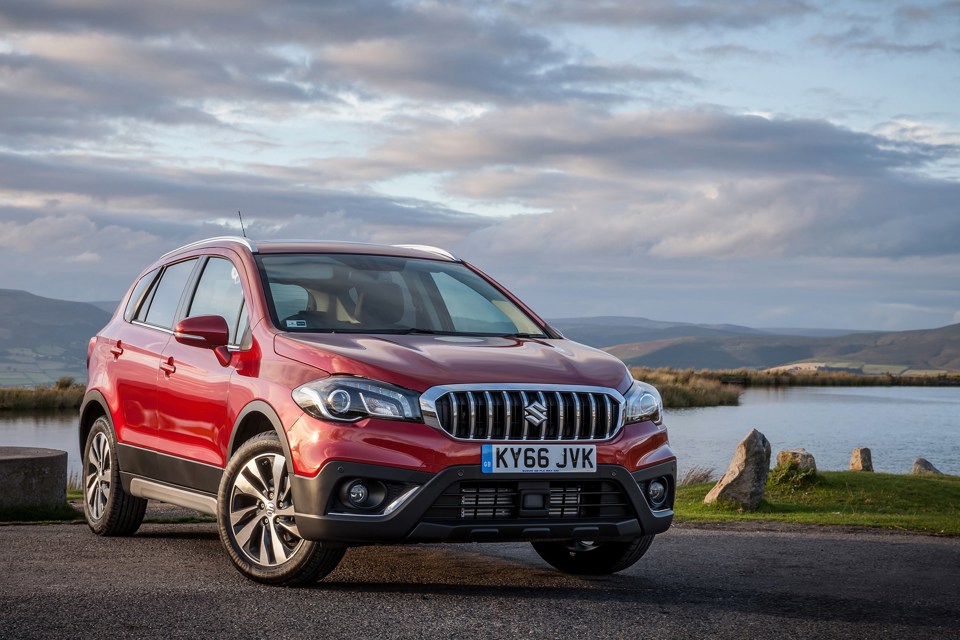Suzuki has updated its S-Cross crossover model, with more distinctive and upright front end styling.
The highly acclaimed Boosterjet petrol engines first utilised in the Vitara S and Baleno models are also now available.
All SZ4 models are equipped as standard with seven airbags, ESP, Bluetooth, DAB digital radio, air conditioning, Daytime Running Lights (DRL), 16-inch alloy wheels, cruise control with speed limiter, air conditioning, heated door mirrors, black protective skid plates and black wheel arch extensions.
SZ-T adds LED Projector Headlamps, satellite navigation, polished 17-inch alloy wheels, rear parking camera, front and rear parking proximity sensors, Dual Zone automatic air conditioning, front fog lamps, rear privacy glass, silver roof rails and silver rear skid plates. Suzuki introduced the SZ-T model specifically with Fleet buyers in mind, although it is available to retail customers as well.
Equipment for the top of the range SZ5 model includes Radar Brake Support (RBS), leather seat upholstery, heated front seats, double sliding panoramic sunroof and aluminium roof rails.
CO2 emissions are from 113g/km for the 1.0-litre 2WD model and 119g/km with optional automatic transmission. The DDiS 2WD model achieves even lower CO2 emissions of 106g/km that result in an annual VED charge of £20.
Historically, power and torque delivery from a turbocharged engine would not have been available until much higher engine speeds, offering less flexibility to the driver.
This unit has an output of 111hp and is also Direct Injection turbocharged (DITC). The engine has very compact dimensions and offers 170Nm of torque available from 2,000rpm through to 3,500rpm. The 1.0-litre engine offers nine per cent more torque than the outgoing 1.6-litre petrol together with 11 per cent lower CO2 emissions and 10 per cent improved combined fuel consumption.
The 1.4-litre Boosterjet engine has a power output of 140hp and offers 220Nm of torque available from just 1,500rpm which is 41 per cent more than the outgoing 1.6-litre engine.
This engine is also 17% more powerful and four per cent more economical versus the 1.6-litre unit.
The 1.4-litre engine offers strong benefits in performance too with a 0-62mph acceleration time of 10.2 seconds for both manual and automatic transmissions and a maximum speed (where permitted) of 124mph.
The 1.6-litre DDiS engine has a torque output of 320Nm from just 1,750rpm and uses a variable geometry turbocharger (VGT). The VGT gives optimal forced induction by controlling the flow of exhaust gases in accordance with the engine speed, thereby helping to achieve high torque, low fuel consumption and low particulate emissions.
An Engine Auto Stop Start system is used on all S-Cross models which shuts down the engine when stationary.
Suzuki evolved its renowned four wheel drive technologies into a new generation that delivers driving pleasure and peace of mind in diverse conditions while promoting economy and limiting the burden four wheel drive cars place on the environment.
Suzuki’s Allgrip system is available on SZ-T and SZ5 models. It has four driver-selectable modes for safe, enjoyable driving on diverse surfaces. It debuted in the S-Cross model at first launch and has proved very successful in both this model and Vitara. In development, the ALLGRIP system was enhanced by the addition of a feed forward function that allocates torque to the rear wheels before any slippage can occur.
Four-wheel drive models see CO2 emissions for the new 1.0-litre Boosterjet petrol engine with manual transmission from 119g/km for the 1.0-litre and 127g/km for the 1.4-litre. The optional automatic transmission equipped 1.4-litre model is only 1g higher. The S-Cross with 1.6-litre DDiS engine and ALLGRIP has a figure of 114g/km.
The facelift S-Cross goes on sale on October 17 with full year sales projection in 2017 of around 5,000 units.
















Login to comment
Comments
No comments have been made yet.